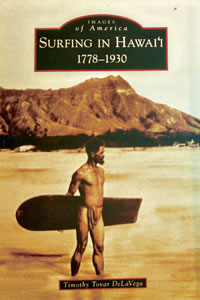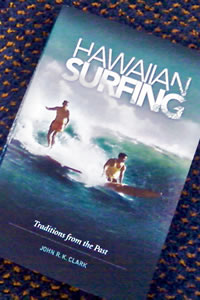Two Great Hawaii Surfing Books

Wednesday - August 03, 2011
| Share
 Del.icio.us
Del.icio.us
|
I remember my first surfing lesson out at worldfamous Canoes in Waikiki like it was yesterday. I was nearly 8, and a family friend believed my swimming skills were strong enough to learn the sport correctly. He called his friend and asked if he could share his wisdom and knowledge with me.
Rabbit Kekai willingly said yes. I had no idea I was learning from a surfing legend.
That was 38 years ago. I was recently reminded about that warm summer morning while diving into a great book. There are dozens of surf books for sale at stores and on various Internet sites and most are interesting and solid reading. But it’s been awhile since I’ve come across a book written in our own backyard that had me staying up late at night because I just couldn’t put it down.
But it gets better. There are two books out there and both are “must-reads” if you’re a surfer or a history buff who wants to learn more about Hawaii.
The first book, Surfing in Hawaii: 1778-1930, is written by Kauai resident and surf historian Timothy DeLaVega. If you love old Hawaiian photos and art and I mean vintage, classic images then this book is for you.
DeLaVega has done an incredible job compiling more than 200 surfing images, some never seen before. From a petroglyph to memorable photos of Duke Kahanamoku and Waikiki beachboys, it is obvious DeLaVega has taken great care and time properly identifying each photograph and art work. He says it was one of his main goals in taking on this project with hopes of encouraging and promoting future research like this effort.
DeLaVega assembled what he called a “worldwide TEAM (Together Everyone Achieves More) of dedicated surfing fanatics” to help with this project. The western etchings and sketches by European foreigners who arrived on our shores send readers back in time.

|
Early visitors such as Henry T. Cheever were amazed at the skill level of Hawaiians as Cheever described, “The sport is so attractive and full of wild excitement to Hawaiians, and withal so healthful, that I cannot but hope it will be many years before civilization shall look at it of countenance, or make it disreputable to indulge in this manly though dangerous exercise.”
Cheever was spot on and so was DeLaVega with this one.
The second book was written by one of Hawaii’s finest historians and a man I have deep respect for, John R.K. Clark. I have had the opportunity to work with the experienced waterman, former lifeguard, retired deputy fire chief and historian/author on several projects, and I’ve read many of his previous (seven) books, but Hawaiian Surfing: Traditions from the Past is in my opinion, his finest work.
The book is a combination of Hawaiian history and Hawaiian language built around Hawaii’s rich surfing history. Clark conducted extensive research of the online archive of Hawaiian language called Hoolaupai, along with translations from the Hawaiian Dictionary and many of Hawaii’s most respected Hawaiian language educators.
The book is filled with texts taken from Hawaiian language newspapers of the 1800s which are translated into English. It also includes dozens of personal and firsthand references to surfing and other wave-riding sports like outrigger canoe surfing, bodyboarding and bodysurfing.
The final 334 pages of the near 500 page book is one of the most remarkable references I’ve ever seen and one that will be used by generations to come. The Hawaiian-English dictionary of surfing terms and Waikiki place names related to surfing reveal Clark’s true love for the sport. You will be amazed by what he has gathered.
Clark caught his first wave in 1954 at worldfamous Canoes at Waikiki Beach, the same break that I did back in 1973. Reading these books has given me a greater appreciation for the ocean I treasure.
Surfing in Hawaii: 1778-1930, Hawaiian Surfing: Traditions from the Past two must-gets for any surfer or anyone who appreciates Hawaiian history.
E-mail this story | Print this page | Comments (0) | Archive | RSS Comments (0) |
Most Recent Comment(s):













